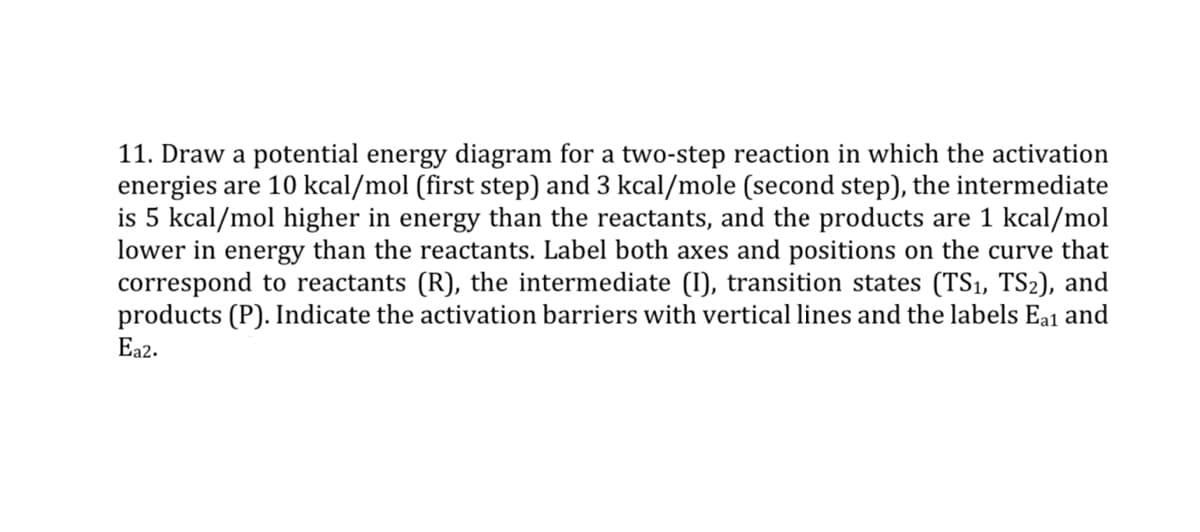11. Draw a potential energy diagram for a two-step reaction in which the activation energies are 10 kcal/mol (first step) and 3 kcal/mole (second step), the intermediate is 5 kcal/mol higher in energy than the reactants, and the products are 1 kcal/mol lower in energy than the reactants. Label both axes and positions on the curve that correspond to reactants (R), the intermediate (I), transition states (TS₁, TS2), and products (P). Indicate the activation barriers with vertical lines and the labels Eat and Ea2.
11. Draw a potential energy diagram for a two-step reaction in which the activation energies are 10 kcal/mol (first step) and 3 kcal/mole (second step), the intermediate is 5 kcal/mol higher in energy than the reactants, and the products are 1 kcal/mol lower in energy than the reactants. Label both axes and positions on the curve that correspond to reactants (R), the intermediate (I), transition states (TS₁, TS2), and products (P). Indicate the activation barriers with vertical lines and the labels Eat and Ea2.
Chemistry for Today: General, Organic, and Biochemistry
9th Edition
ISBN:9781305960060
Author:Spencer L. Seager, Michael R. Slabaugh, Maren S. Hansen
Publisher:Spencer L. Seager, Michael R. Slabaugh, Maren S. Hansen
Chapter8: Reaction Rates And Equilibrium
Section: Chapter Questions
Problem 8.26E
Related questions
Question

Transcribed Image Text:11. Draw a potential energy diagram for a two-step reaction in which the activation
energies are 10 kcal/mol (first step) and 3 kcal/mole (second step), the intermediate
is 5 kcal/mol higher in energy than the reactants, and the products are 1 kcal/mol
lower in energy than the reactants. Label both axes and positions on the curve that
correspond to reactants (R), the intermediate (I), transition states (TS₁, TS₂), and
products (P). Indicate the activation barriers with vertical lines and the labels Ea1 and
Ea2.
Expert Solution
This question has been solved!
Explore an expertly crafted, step-by-step solution for a thorough understanding of key concepts.
Step by step
Solved in 2 steps with 2 images

Knowledge Booster
Learn more about
Need a deep-dive on the concept behind this application? Look no further. Learn more about this topic, chemistry and related others by exploring similar questions and additional content below.Recommended textbooks for you

Chemistry for Today: General, Organic, and Bioche…
Chemistry
ISBN:
9781305960060
Author:
Spencer L. Seager, Michael R. Slabaugh, Maren S. Hansen
Publisher:
Cengage Learning

Introductory Chemistry: A Foundation
Chemistry
ISBN:
9781337399425
Author:
Steven S. Zumdahl, Donald J. DeCoste
Publisher:
Cengage Learning


Chemistry for Today: General, Organic, and Bioche…
Chemistry
ISBN:
9781305960060
Author:
Spencer L. Seager, Michael R. Slabaugh, Maren S. Hansen
Publisher:
Cengage Learning

Introductory Chemistry: A Foundation
Chemistry
ISBN:
9781337399425
Author:
Steven S. Zumdahl, Donald J. DeCoste
Publisher:
Cengage Learning


Chemistry: Matter and Change
Chemistry
ISBN:
9780078746376
Author:
Dinah Zike, Laurel Dingrando, Nicholas Hainen, Cheryl Wistrom
Publisher:
Glencoe/McGraw-Hill School Pub Co

Chemistry & Chemical Reactivity
Chemistry
ISBN:
9781133949640
Author:
John C. Kotz, Paul M. Treichel, John Townsend, David Treichel
Publisher:
Cengage Learning

Chemistry: The Molecular Science
Chemistry
ISBN:
9781285199047
Author:
John W. Moore, Conrad L. Stanitski
Publisher:
Cengage Learning